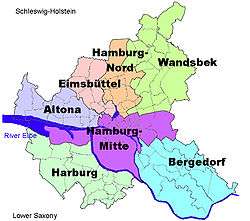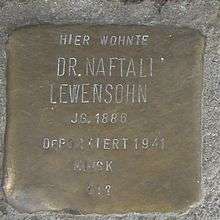Bergedorf
- For the quarter and the train station, see Bergedorf (quarter) and Hamburg-Bergedorf station.
| Bergedorf | ||
|---|---|---|
|
The small harbour in Bergedorf. | ||
| ||
 | ||
Boroughs of Hamburg  | ||
| Coordinates: 53°29′14″N 10°12′37″E / 53.48722°N 10.21028°ECoordinates: 53°29′14″N 10°12′37″E / 53.48722°N 10.21028°E | ||
| Country | Germany | |
| State | Hamburg | |
| City | Hamburg | |
| Area | ||
| • Total | 154.8 km2 (59.8 sq mi) | |
| Population (1-1-2006) | ||
| • Total | 118,942 | |
| • Density | 770/km2 (2,000/sq mi) | |
| Time zone | CET/CEST (UTC+1/+2) | |
| Dialling codes | 040 | |
| Vehicle registration | HH | |
Bergedorf (German pronunciation: [ˈbɛʁɡədɔʁf]) is the largest of the seven boroughs of Hamburg, Germany, named after a quarter within this borough. In 2006 the population of the borough was 118,942.
History
The city of Bergedorf received town privileges in 1275, then a part of the younger Duchy of Saxony (1180–1296), which was partitioned by its four co-ruling dukes in 1296 into the branch duchies of Saxe-Lauenburg and Saxe-Wittenberg. Bergedorf then became part of the former. This was only to last until 1303, when Lauenburg's three co-ruling dukes, Albert III, Eric I, and John II partitioned their branch duchy into three smaller duchies.
Eric then held Bergedorf (Vierlande) and Lauenburg and inherited the share of his childless brother Albert III, Saxe-Ratzeburg, after he was already deceased in 1308 and a retained section from Albert's widow Margaret of Brandenburg-Salzwedel on her death.[1] However, his other brother, John II, then claimed a part, so in 1321 Eric conceded Bergedorf (with Vierlande) to him, whose share thus became known thereafter as Saxe-Bergedorf-Mölln while Eric's was known as Saxe-Ratzeburg-Lauenburg.
In 1370, John's fourth successor Eric III pawned the Herrschaft of Bergedorf, the Vierlande, half the Saxon Wood and Geesthacht to Lübeck in return for a credit of 16,262.5 Lübeck marks.[2] This acquisition included much of the trade route between Hamburg and Lübeck, thus providing a safe passage for freight between the cities. Eric III only retained a life tenancy.
The city of Lübeck and Eric III further stipulated, that upon his death, Lübeck would be entitled to take possession of the pawned areas until his successors repaid the credit and simultaneously exercised the repurchase of Mölln (contracted in 1359), altogether amounting to the then enormous sum of 26,000 Lübeck Marks.[3]
In 1401, Eric III died without issue and was succeeded by his second cousin Eric IV of Saxe-Ratzeburg-Lauenburg. In the same year, Eric IV, supported by his sons Eric (later ruling as Eric V) and John, forcefully captured the pawned areas without making any repayment, before Lübeck could take possession of them. Lübeck acquiesced for the time being.[4]
In 1420, Eric V attacked Prince-Elector Frederick I of Brandenburg and Lübeck allied with Hamburg in support of Brandenburg. Armies of both cities opened a second front and conquered Bergedorf, Riepenburg castle and the Esslingen river toll station (today's Zollenspieker Ferry) within weeks. This forced Eric V to agree with Hamburg's burgomaster Hein Hoyer and Burgomaster Jordan Pleskow of Lübeck to the Peace of Perleberg on 23 August 1420, which stipulated that all the pawned areas, which Eric IV, Eric V and John IV had violently taken in 1401, were to be irrevocably ceded to the cities of Hamburg and Lübeck.
Hamburg-Lübeck Condominium
The cities transformed the acquired areas into the "Beiderstädtischer Besitz" (bi-urban condominium; cooperatively governed possession), ruled by bailiffs in four year terms, alternately staffed by one of the cities. In 1446 the bailiffs' terms were increased to six years, and in 1620 to life terms. In 1542 bailiff Ditmar Koel introduced the Protestant Reformation in the co-governed municipalities. The area was formally annexed to the First French Empire as part of Bouches de l'Elbe département between 1811 and 1813. Thereafter, the area was restored to Hamburg and Lübeck, both sovereign states. The first railway in Northern Germany was opened between Hamburg and Bergedorf by the Hamburg-Bergedorf Railway Company in 1842. In the 1860s the Condominium issued its own postage stamps.
Hamburg rural seigniory
Effective of 1 January 1868 Lübeck sold its share in the bi-urban condominium to the Free and Hanseatic City of Hamburg for 200,000 Prussian thaler. Hamburg integrated the area into its state territory, forming there the Landherrenschaft Bergedorf (i.e. Bergedorf rural seigniory) comprising the cities of Bergedorf and Geesthacht and a number of rural municipalities not integrated into the city of Hamburg proper. By the Greater Hamburg Act of 1937 the exclave of Geesthacht was ceded to Schleswig-Holstein.
Bergedorf Borough of Hamburg
On 1 April 1938 Bergedorf city and the other municipalities became the Borough of Bergedorf, an integrated part of the city of Hamburg. Bergedorf is also known by its nickname Garden of Hamburg.
Geography
The borough of Bergedorf consists of the quarters Allermöhe, Altengamme, Bergedorf, Billwerder, Curslack, Kirchwerder, Lohbrügge, Moorfleet, Neuallermöhe (a new quarter since January 2011).Neuengamme, Ochsenwerder, Reitbrook, Spadenland and Tatenberg.
In 2006, according to the statistical office of Hamburg and Schleswig-Holstein, the borough of Bergedorf has a total area of 154.8 square kilometres (60 sq mi).
Today's quarter is the old city Bergedorf, located on the river Bille, a right tributary of the Elbe.
Demographics
In 2006, 118,942 people were living in Bergedorf borough. The population density was 769 inhabitants per square kilometre (1,992/sq mi). 19.3% were children under the age of 18, and 18.2% were 65 years of age or older. 9.6% were immigrants. 6,027 people were registered as unemployed.[5] In 1999 there were 51,752 households and 34.6% of all households were made up of individuals.[6]
According to the Department of Motor Vehicles (Kraftfahrt-Bundesamt), there were 48,003 private cars registered (406 cars/1000 people)in the borough of Bergedorf.[7]
There were 22 elementary schools, 16 secondary schools, 184 physicians in private practice, and 23 pharmacies in the borough of Bergedorf.[7] These numbers include the Bergedorf quarter.
Diet of the borough
The Bezirksversammlung is elected as representatives of the citizens, simultaneously with elections to the state parliament (Bürgerschaft). It consists of 47 representatives.
Elections
Elections were held in Hamburg on 24 February 2008. The four parties having more than 5 percent in recent polls (minimum to qualify) are the conservative CDU, the social-democratic SPD, the ecologist Green Party (GAL), the left-wing Die Linke. The liberal Free Democratic Party (FDP) has 2 directly elected representatives. Voter participation was 58.5%.[8]
| Party | Percent | Seats |
|---|---|---|
| CDU | 42.1 | 21 |
| SPD | 34.5 | 17 |
| GAL | 9.9 | 5 |
| Die Linke | 4.8 | 1 |
| FDP | 6.6 | 3 |
Postage stamps

Bergedorf is of note to philatelists because it issued its own postage stamps in 1861. At that time it had 2,989 residents, making it by far the smallest of the German towns to do so. The issue included 5 square stamps with denominations from ½ to 4 schillings. All used the same design - a combined coat of arms of Hamburg and Lübeck - but the higher values were larger stamps. All values were printed in black on different colored papers, except for the 3s stamp, which was printed in blue on pink paper.
Since Bergedorf was such a small town, relatively few of these stamps were made, and even fewer used; the price of unused stamps is from US$30–$50, while genuinely used stamps go for US$300–$2,000. Reprints, forgeries, and especially faked cancellations are quite common.
Bergedorf began using stamps of the North German Confederation in 1868.
Notable structures


- Church "St. Petri and Pauli"
- Fernmeldeturm Hamburg-Bergedorf
- Transmitter Hamburg-Billstedt
- Hamburger Sternwarte also called Hamburg-Bergedorf Observatory
- Schloss Bergedorf
Notable persons
- Ida Boy-Ed (1852–1928), writer
- Johann Adolph Hasse, (1699–1783), composer
- Alfred Lichtwark (1852–1914), director of the Hamburger Kunsthalle
- Ferdinand Pfohl (1862–1949), music critic, music writer and composer
Notes
- ↑ Cordula Bornefeld, "Die Herzöge von Sachsen-Lauenburg", in: Die Fürsten des Landes: Herzöge und Grafen von Schleswig, Holstein und Lauenburg [De slevigske hertuger; German], Carsten Porskrog Rasmussen (ed.) on behalf of the Gesellschaft für Schleswig-Holsteinische Geschichte, Neumünster: Wachholtz, 2008, pp. 373-389, here p. 377. ISBN 978-3-529-02606-5
- ↑ Elisabeth Raiser, Städtische Territorialpolitik im Mittelalter: eine vergleichende Untersuchung ihrer verschiedenen Formen am Beispiel Lübecks und Zürichs, Lübeck and Hamburg: Matthiesen, 1969, (Historische Studien; 406), p. 90, simultaneously: Hamburg, Univ., Diss., 1969.
- ↑ Elisabeth Raiser, Städtische Territorialpolitik im Mittelalter: eine vergleichende Untersuchung ihrer verschiedenen Formen am Beispiel Lübecks und Zürichs, Lübeck and Hamburg: Matthiesen, 1969, (Historische Studien; 406), pp. 90seq., simultaneously: Hamburg, Univ., Diss., 1969.
- ↑ Elisabeth Raiser, Städtische Territorialpolitik im Mittelalter: eine vergleichende Untersuchung ihrer verschiedenen Formen am Beispiel Lübecks und Zürichs, Lübeck and Hamburg: Matthiesen, 1969, (Historische Studien; 406), p. 137, simultaneously: Hamburg, Univ., Diss., 1969.
- ↑ Residents registration office, source: statistical office Nord of Hamburg and Schleswig-Holstein (2006)
- ↑ Source: statistical office Nord of Hamburg and Schleswig-Holstein (1999)
- 1 2 Source: statistical office Nord of Hamburg and Schleswig-Holstein (2006)
- ↑ Final election result, source: statistical office of Hamburg and Schleswig-Holstein (2008)
References
Bibliography
- Harald Richert: Bergedorf - eine selbständige Stadt. In: Lichtwark Nr. 54. Hrsg. Lichtwark-Ausschuß, Bergedorf, 1991. Jetzt: Verlag HB-Werbung, Hamburg-Bergedorf. ISSN 1862-3549.
External links
| Wikimedia Commons has media related to Bergedorf. |
| Wikisource has the text of the 1920 Encyclopedia Americana article Bergedorf. |
- Bergedorf homepage (in German)
- Bergedorf Round Table of the Koerber Foundation
- privat Bergedorf Citypage (in German)
